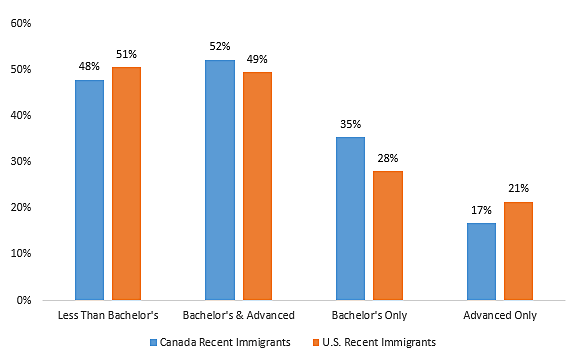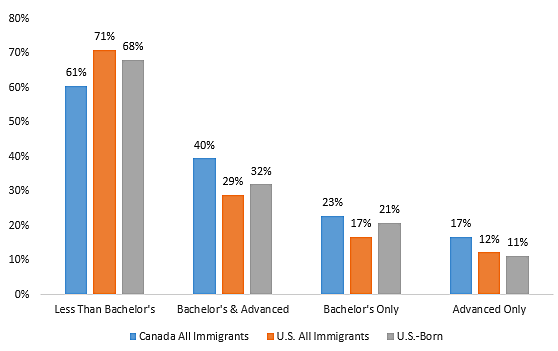President Trump wants to cut legal immigration by more than 40 percent, complaining that the system focuses on family reunification rather than skills. In defending the plan, Attorney General Jeff Sessions generalized today’s immigrants as largely “illiterate”, with “no skills”, and argued that America “should be like Canada” on immigration, evaluating them on their skills. Yet, recent U.S. immigrants are better educated the U.S.-born, and differ little from recent Canadian immigrants.
Figure 1 provides the educational attainment distribution for U.S.-born working-age adults (25–64) compared to recent U.S. working-age immigrants (arrival from 2012 to 2016). As it shows, nearly half of all recent working-age immigrants had a college degree or higher, compared to just 32 percent of the U.S.-born working-age population. Recent immigrant workers to America are 50 percent more likely to have graduated college than U.S.-born workers. Moreover, among college graduates they are much more likely to have advanced degrees.
Figure 1: U.S.-Born Citizens and Recent Immigrants to the United States by Education, Ages 25–64*
Sources: American Community Survey, 2016 5‑Year Sample *Including all adults over 25 reduces recent immigrant share of bachelor’s degrees to 47 percent and U.S.-born share to 30 percent
Figure 2 provides the educational attainment distribution for recent working-age immigrants to the United States compared to recent working-age immigrants to Canada (arrival from 2012 to 2016). As it shows, recent working-age Canadian and U.S. immigrants have very similar educational profiles, with an almost equal ratio of college graduates to non-graduates. U.S. recent immigrants with a college degree are a bit more likely to have an advanced degree.
Figure 2: Recent Immigrants to the United States and Canada by Education, Ages 25–64
Sources: American Community Survey, 2016 5‑Year Sample; Statistics Canada
Canada’s overall immigrant population is slightly better educated than the United States’. Figure 3 provides the educational attainment distribution for all working-age immigrants to the United States compared to all working-age immigrants to Canada. Even looking at the entire population, however, the U.S. immigrant population ends up looking very similar to the U.S.-born population, with only minor differences in educational attainment.
Figure 3: Recent Immigrants to the United States and Canada by Education, Ages 25–64
Sources: American Community Survey, 2016 5‑Year Sample; Statistics Canada
These figures modestly understate the degree to which the U.S. legal system results in the immigration of educated workers because nearly a quarter of all U.S. immigrants are illegal, and illegal immigrants are less educated than other immigrants. Canada has relatively fewer illegal immigrants.
More important than the shares of the flow is the absolute quantity of the flow to each country. While Canada has a similar share of less educated immigrants, it allows far more of them to immigrate, relative to its population, because its immigration rate is so much higher than the U.S. rate. In other words, the United States is far less welcoming overall to less educated immigrants than our northern neighbor.
The claim that U.S. legal immigration policy is highly skewed toward “illiterates” who lack skills to succeed in America has no validity. In fact, even family-sponsored immigrants and diversity lottery winners are better educated than the U.S.-born. In any case, less educated immigrants bring skills and contribute in important ways to the United States, and they are successful on all standard measures. But ultimately, reforming immigration policies should start with the facts about the immigrants that we already have, not myths and conjecture.



